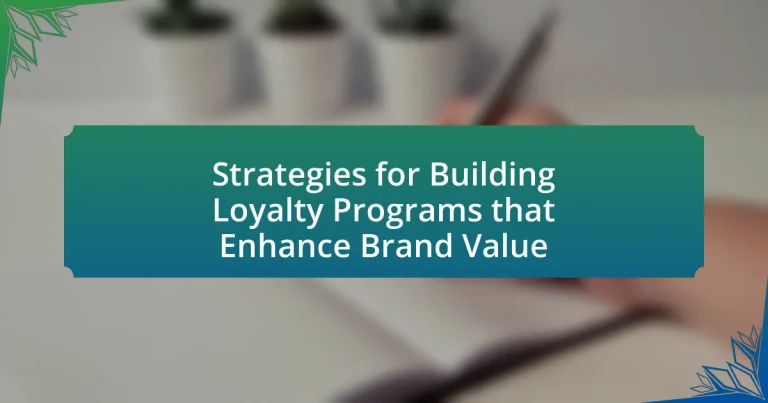Loyalty programs are structured marketing strategies aimed at encouraging repeat business by rewarding customers for their continued patronage. This article explores the significance of loyalty programs in enhancing brand value through customer retention, increased lifetime value, and improved brand loyalty. Key elements contributing to effective loyalty programs include personalized rewards, customer engagement, and data analytics, which are essential for tailoring offerings to customer behaviors. Additionally, the article discusses strategies for measuring program success, refining loyalty initiatives, and avoiding common pitfalls, ultimately providing a comprehensive guide for brands looking to build effective loyalty programs that drive profitability and customer satisfaction.

What are Loyalty Programs and Why are They Important for Brand Value?
Loyalty programs are structured marketing strategies designed to encourage repeat business by offering rewards to customers for their continued patronage. These programs are important for brand value because they foster customer retention, increase customer lifetime value, and enhance brand loyalty. Research indicates that loyal customers are worth up to ten times as much as their first purchase, demonstrating that effective loyalty programs can significantly boost a brand’s profitability and market position. Additionally, brands with strong loyalty programs often enjoy higher customer satisfaction rates, which can lead to positive word-of-mouth and increased brand equity.
How do Loyalty Programs function in enhancing customer retention?
Loyalty programs enhance customer retention by incentivizing repeat purchases through rewards and benefits. These programs create a sense of belonging and appreciation among customers, which fosters emotional connections to the brand. For instance, a study by the Harvard Business Review found that increasing customer retention rates by just 5% can lead to an increase in profits of 25% to 95%. This demonstrates that loyalty programs not only encourage customers to return but also significantly impact a company’s bottom line.
What key elements contribute to the effectiveness of Loyalty Programs?
Key elements that contribute to the effectiveness of loyalty programs include personalized rewards, customer engagement, and data analytics. Personalized rewards enhance customer satisfaction by aligning incentives with individual preferences, leading to increased participation and retention. Customer engagement strategies, such as regular communication and exclusive offers, foster a sense of belonging and encourage repeat purchases. Data analytics allows businesses to track customer behavior and preferences, enabling them to tailor their offerings and improve program effectiveness. Research indicates that companies with well-structured loyalty programs can see a 5-10% increase in revenue, demonstrating the tangible benefits of these key elements.
How do customer behaviors influence the design of Loyalty Programs?
Customer behaviors significantly influence the design of loyalty programs by dictating the types of rewards and engagement strategies that resonate with consumers. For instance, data shows that 79% of consumers are more likely to engage with brands that offer personalized rewards, indicating that understanding customer preferences is crucial for program effectiveness. Additionally, behaviors such as frequency of purchase and brand interaction inform the tiered structures of loyalty programs, allowing businesses to tailor incentives that encourage repeat purchases and deeper brand loyalty. This alignment between customer behaviors and program design not only enhances customer satisfaction but also drives long-term brand value.
What role does customer engagement play in Loyalty Programs?
Customer engagement is crucial in loyalty programs as it directly influences customer retention and brand loyalty. Engaged customers are more likely to participate actively in loyalty initiatives, leading to increased spending and advocacy for the brand. Research indicates that companies with high customer engagement levels can see a 23% increase in revenue, as engaged customers tend to make repeat purchases and refer others. Furthermore, effective engagement strategies, such as personalized communication and rewards, enhance the overall customer experience, fostering a deeper emotional connection with the brand. This connection not only drives loyalty but also enhances brand value in a competitive market.
How can brands measure customer engagement within their Loyalty Programs?
Brands can measure customer engagement within their loyalty programs by analyzing key performance indicators (KPIs) such as participation rates, redemption rates, and customer feedback. Participation rates indicate how many customers are actively engaging with the program, while redemption rates reveal how often customers utilize their rewards, reflecting the program’s attractiveness. Additionally, collecting customer feedback through surveys or direct interactions provides qualitative insights into customer satisfaction and areas for improvement. Research shows that companies with effective loyalty programs see a 5-10% increase in customer retention, highlighting the importance of measuring engagement to enhance brand value.
What strategies can enhance customer engagement in Loyalty Programs?
Implementing personalized communication is a key strategy to enhance customer engagement in loyalty programs. Personalization increases relevance, making customers feel valued and understood, which can lead to higher participation rates. According to a study by Epsilon, 80% of consumers are more likely to make a purchase when brands offer personalized experiences. Additionally, integrating gamification elements, such as rewards for specific actions or milestones, can significantly boost engagement. Research from the Journal of Business Research indicates that gamified loyalty programs can increase customer retention by up to 30%. Lastly, utilizing data analytics to tailor offers and rewards based on customer behavior ensures that the loyalty program remains appealing and effective, as evidenced by a report from McKinsey, which found that data-driven personalization can lead to a 10-15% increase in sales.

What Strategies Can Brands Implement to Build Effective Loyalty Programs?
Brands can implement several strategies to build effective loyalty programs, including personalized rewards, tiered membership levels, and data-driven engagement. Personalized rewards enhance customer experience by tailoring offers based on individual preferences and purchase history, which can increase customer retention by up to 30%, according to a study by Accenture. Tiered membership levels incentivize customers to increase their spending to achieve higher status, fostering a sense of exclusivity and encouraging loyalty. Data-driven engagement allows brands to analyze customer behavior and preferences, enabling them to create targeted marketing campaigns that resonate with their audience, ultimately leading to a 20% increase in customer loyalty, as reported by McKinsey.
How can brands identify their target audience for Loyalty Programs?
Brands can identify their target audience for loyalty programs by analyzing customer data and behavior patterns. This involves collecting demographic information, purchase history, and engagement metrics to segment customers effectively. For instance, a study by McKinsey & Company found that companies using data analytics to understand customer preferences can increase their loyalty program effectiveness by up to 20%. By leveraging tools like surveys and social media insights, brands can further refine their understanding of customer motivations and preferences, ensuring that loyalty programs resonate with the right audience.
What methods can be used to gather customer insights for program design?
Surveys and interviews are effective methods to gather customer insights for program design. Surveys allow businesses to collect quantitative data on customer preferences and behaviors, while interviews provide qualitative insights into customer motivations and experiences. According to a study by the Harvard Business Review, companies that utilize customer feedback through these methods can increase customer satisfaction by up to 20%. Additionally, focus groups can be employed to facilitate discussions among customers, revealing deeper insights into their needs and expectations. These methods collectively enable businesses to tailor loyalty programs that resonate with their target audience, ultimately enhancing brand value.
How does understanding customer demographics shape Loyalty Program strategies?
Understanding customer demographics shapes Loyalty Program strategies by enabling businesses to tailor rewards and communication to specific customer segments. For instance, data from the 2021 Loyalty Report by Bond Brand Loyalty indicates that 77% of consumers are more likely to engage with a loyalty program that offers personalized rewards based on their preferences and behaviors. By analyzing age, income, and purchasing habits, companies can design programs that resonate with different demographic groups, enhancing customer satisfaction and retention. This targeted approach not only increases program effectiveness but also drives higher customer lifetime value, as evidenced by a study from McKinsey, which found that personalized experiences can lead to a 10-30% increase in revenue.
What types of rewards can be offered in Loyalty Programs?
Loyalty programs can offer various types of rewards, including points-based rewards, discounts, exclusive access, and tiered benefits. Points-based rewards allow customers to accumulate points for purchases, which can be redeemed for products or services. Discounts provide immediate savings on future purchases, incentivizing repeat business. Exclusive access rewards may include early product releases or special events, enhancing customer engagement. Tiered benefits reward customers based on their spending levels, encouraging higher spending to unlock greater rewards. These reward types are effective in fostering customer loyalty and increasing brand value, as evidenced by studies showing that 79% of consumers are more likely to continue doing business with brands that offer loyalty programs.
How do different reward structures impact customer motivation?
Different reward structures significantly impact customer motivation by influencing their engagement and purchasing behavior. For instance, tiered reward systems, which offer increasing benefits based on customer spending, can motivate customers to spend more to reach higher tiers, as evidenced by a study from the Journal of Marketing Research that found tiered rewards increase customer spending by 20% compared to flat rewards. Additionally, instant rewards, such as discounts or cashback, can create immediate gratification, leading to increased customer satisfaction and repeat purchases. Research from the Harvard Business Review indicates that customers are 30% more likely to return when they receive immediate rewards. Therefore, the design of reward structures plays a crucial role in shaping customer motivation and loyalty.
What are the advantages of tiered rewards in Loyalty Programs?
Tiered rewards in loyalty programs offer several advantages, including increased customer engagement, enhanced perceived value, and improved retention rates. By structuring rewards into tiers, businesses can motivate customers to reach higher levels of spending or engagement, which fosters a sense of achievement and loyalty. Research indicates that tiered systems can lead to a 20% increase in customer retention, as customers are incentivized to maintain their status and continue purchasing to unlock better rewards. Additionally, tiered rewards create a competitive environment among customers, encouraging them to strive for higher tiers, which can ultimately boost overall sales and brand loyalty.

How Can Brands Measure the Success of Their Loyalty Programs?
Brands can measure the success of their loyalty programs through key performance indicators (KPIs) such as customer retention rate, average transaction value, and program participation rates. Customer retention rate indicates how effectively a brand retains its customers over time, with a higher retention rate often correlating with a successful loyalty program. Average transaction value reflects the increase in spending from loyal customers compared to non-loyal customers, providing insight into the program’s financial impact. Program participation rates show the percentage of customers actively engaging with the loyalty program, which can be a direct measure of its appeal and effectiveness. According to a study by Bond Brand Loyalty, 79% of consumers are more likely to continue doing business with a brand that has a loyalty program, highlighting the importance of these metrics in assessing program success.
What key performance indicators (KPIs) should be tracked?
Key performance indicators (KPIs) that should be tracked for loyalty programs include customer retention rate, average transaction value, frequency of purchase, and customer lifetime value. Customer retention rate measures the percentage of customers who continue to engage with the brand over a specific period, indicating the effectiveness of the loyalty program. Average transaction value reflects the average amount spent by customers during each transaction, which can be influenced by loyalty incentives. Frequency of purchase tracks how often customers make purchases, providing insight into engagement levels. Customer lifetime value estimates the total revenue a business can expect from a customer throughout their relationship, highlighting the long-term impact of loyalty initiatives. These KPIs are essential for assessing the success and impact of loyalty programs on brand value.
How can customer lifetime value be calculated in relation to Loyalty Programs?
Customer lifetime value (CLV) can be calculated in relation to loyalty programs by analyzing the incremental revenue generated from loyal customers over their entire relationship with the brand. This involves estimating the average purchase value, purchase frequency, and customer lifespan, then adjusting these figures based on the additional benefits provided by the loyalty program, such as discounts or rewards.
To calculate CLV specifically for loyalty program participants, businesses can use the formula: CLV = (Average Purchase Value x Purchase Frequency x Customer Lifespan) + Loyalty Program Benefits. For instance, if a customer typically spends $100 per purchase, makes 5 purchases a year, and remains a customer for 10 years, the base CLV would be $5,000. If the loyalty program adds an estimated $500 in rewards over that period, the adjusted CLV would be $5,500.
This method is validated by research indicating that loyalty program members tend to spend more than non-members, with a study by Bain & Company showing that loyal customers can be worth up to 10 times more than their first purchase. Thus, incorporating loyalty program benefits into CLV calculations provides a more accurate representation of a customer’s value to the business.
What role does customer feedback play in evaluating program success?
Customer feedback is crucial in evaluating program success as it provides direct insights into customer satisfaction and engagement levels. By analyzing feedback, organizations can identify strengths and weaknesses in their loyalty programs, allowing for targeted improvements. For instance, a study by Bain & Company found that companies that actively seek and respond to customer feedback can increase customer retention rates by up to 25%. This demonstrates that leveraging customer insights not only enhances program effectiveness but also fosters brand loyalty, ultimately contributing to overall business success.
How can brands adapt their Loyalty Programs based on performance data?
Brands can adapt their Loyalty Programs based on performance data by analyzing customer engagement metrics and purchasing behaviors to tailor rewards and incentives. For instance, if data reveals that customers respond positively to specific rewards, brands can increase the frequency or value of those rewards to enhance customer retention. Additionally, performance data can identify underperforming aspects of the program, allowing brands to modify or eliminate ineffective rewards, thereby optimizing the overall program effectiveness. Research indicates that companies leveraging data analytics for loyalty programs see a 20% increase in customer retention rates, demonstrating the tangible benefits of data-driven adaptations.
What strategies can be employed to refine and improve Loyalty Programs?
To refine and improve Loyalty Programs, businesses should implement personalized rewards, enhance customer engagement through multi-channel communication, and utilize data analytics for targeted marketing. Personalized rewards increase customer satisfaction and retention, as studies show that 80% of consumers are more likely to engage with brands that offer personalized experiences. Multi-channel communication fosters stronger relationships, with 70% of consumers preferring to interact with brands through various platforms. Data analytics allows businesses to understand customer behavior and preferences, enabling tailored offers that can boost program effectiveness.
How often should brands review and update their Loyalty Programs?
Brands should review and update their Loyalty Programs at least annually. Regular assessments help ensure that the programs remain relevant to customer preferences and market trends. Research indicates that 70% of consumers are more likely to engage with brands that adapt their loyalty offerings based on feedback and changing behaviors. By conducting annual reviews, brands can analyze performance metrics, customer satisfaction, and competitive benchmarks, allowing them to make informed adjustments that enhance customer retention and overall brand value.
What are some best practices for creating successful Loyalty Programs?
Successful loyalty programs should focus on personalization, clear rewards, and ease of use. Personalization enhances customer engagement by tailoring offers and communications based on individual preferences and behaviors, which can increase customer retention rates by up to 20% (Bain & Company). Clear rewards structures motivate customers to participate, as 70% of consumers prefer programs that are straightforward and easy to understand (Colloquy). Additionally, ensuring that the program is easy to join and use can significantly improve participation rates; research indicates that programs with simple enrollment processes see a 50% higher sign-up rate (LoyaltyOne).
How can personalization enhance the effectiveness of Loyalty Programs?
Personalization enhances the effectiveness of loyalty programs by tailoring rewards and communications to individual customer preferences and behaviors. This targeted approach increases customer engagement, as studies show that personalized experiences can lead to a 20% increase in customer satisfaction and a 10% increase in loyalty program participation. By analyzing customer data, brands can create customized offers that resonate with specific segments, resulting in higher redemption rates and increased spending. For instance, a report by McKinsey indicates that personalization can drive revenue growth by 5% to 15% for businesses that effectively implement these strategies.
What common pitfalls should brands avoid when designing Loyalty Programs?
Brands should avoid creating overly complicated loyalty programs that confuse customers. Complexity can lead to frustration and disengagement, as evidenced by a study from Bond Brand Loyalty, which found that 77% of consumers prefer simple rewards structures. Additionally, brands should not neglect personalization; failing to tailor rewards to individual preferences can diminish customer satisfaction and loyalty. According to a report by Accenture, 91% of consumers are more likely to shop with brands that provide relevant offers and recommendations. Lastly, brands must avoid infrequent communication; lack of engagement can result in customers forgetting about the program, as highlighted by research from LoyaltyOne, which indicates that regular communication increases program participation by up to 50%.




